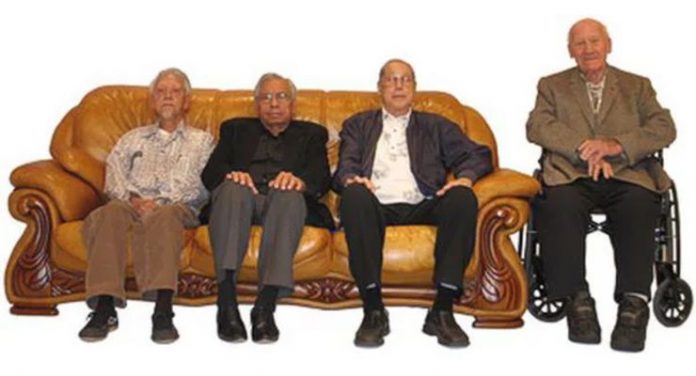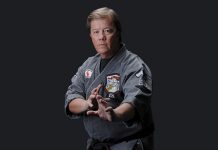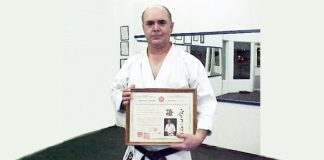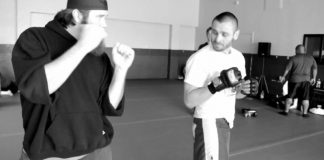Two locations figure prominently in the history of American martial arts. The first is Hawaii. Hawaii has the largest population of Asian Americans of any state in the union. Consequently, Asian immigrants have been bringing martial arts there for decades. Even today, it’s common to see masters donning aloha shirts in honor this island heritage. The other place is San Francisco Bay. Another bastion of Asian immigrants, the Bay Area enjoys the highest density of martial arts schools of anywhere in the nation. It is a prime location for Tiger Claw and KungFuMagazine.com.
 In October of 2006, we had the opportunity to pay our respects to four of the elder Grandmasters of American martial arts: Ralph Castro, Ming Lum, Al Novak and Wally Jay. All four have deep connections to Hawaii. Ralph Castro and Wally Jay were both from Honolulu originally. Ming Lum was born in Guandong, China, but then lived and trained in Honolulu for many years. Al Novak was born in Wisconsin, but served in Hawaii during WWII and survived Pearl Harbor. The spirit of Aloha permeates these great pioneers. Theirs is a legacy of luau fundraisers, congratulatory leis and martial bruddahs.
In October of 2006, we had the opportunity to pay our respects to four of the elder Grandmasters of American martial arts: Ralph Castro, Ming Lum, Al Novak and Wally Jay. All four have deep connections to Hawaii. Ralph Castro and Wally Jay were both from Honolulu originally. Ming Lum was born in Guandong, China, but then lived and trained in Honolulu for many years. Al Novak was born in Wisconsin, but served in Hawaii during WWII and survived Pearl Harbor. The spirit of Aloha permeates these great pioneers. Theirs is a legacy of luau fundraisers, congratulatory leis and martial bruddahs.
Most martial enthusiasts are familiar with these Grandmasters. As our first leaders, they all contributed heavily to the introduction and spread of martial arts in America. They all knew Bruce Lee personally. For the sake of new readers, a short overview of each Grandmaster is provided from youngest to oldest.
At this writing, Grandmaster Ralph Castro is seventy-five. He started his martial arts training at age twenty-one, although he had previous training in boxing and street fighting from his father. His brother-in-law introduced him to Professor William Chow, considered to be the modern-day founder of the kenpo system. Chow also taught American kenpo founder Ed Parker, and the Parker and Castro families were very close. Castro developed his own system of Shaolin Kenpo Karate, which he teaches to this day. Just prior to the ’60s, Castro moved near San Francisco and established his school. He was behind the first large-scale karate championships in the United States. His California Karate Championships are remembered fondly as historic and significant events. Castro has been the recipient of countless awards and accolades over the past several decades. He has seven children, all black belts as well. His daughter, June, has been very prominent as a second-generation master.
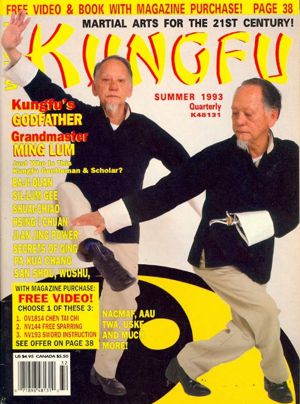 Grandmaster Ming Lum just celebrated his eightieth birthday. He began his training at age Grandmaster Ming Lum on cover of Kung Fu Magazinesix or seven under a village master in China. “We always got into trouble with different villages back then,” quips Ming with a kolohe smile. Ming is known respectfully as the “Godfather of Chinatown” within martial arts circles. He trained in Fut Gar under Grandmaster Lam Dai Yung, Jujitsu under Professor Henry Okazaki and Judo with Professor Ken Kawachi. When he came to San Francisco in the fifties, he studied under Choy Lay Fut Grandmaster Lau Bun. An ardent supporter of the martial arts, Lum helped network masters by making introductions in the early years. He was also the first to start showing the classic kung fu films of the Shaw Brothers to the American public. Ming Lum was featured on the cover of our Summer 1993 issue.
Grandmaster Ming Lum just celebrated his eightieth birthday. He began his training at age Grandmaster Ming Lum on cover of Kung Fu Magazinesix or seven under a village master in China. “We always got into trouble with different villages back then,” quips Ming with a kolohe smile. Ming is known respectfully as the “Godfather of Chinatown” within martial arts circles. He trained in Fut Gar under Grandmaster Lam Dai Yung, Jujitsu under Professor Henry Okazaki and Judo with Professor Ken Kawachi. When he came to San Francisco in the fifties, he studied under Choy Lay Fut Grandmaster Lau Bun. An ardent supporter of the martial arts, Lum helped network masters by making introductions in the early years. He was also the first to start showing the classic kung fu films of the Shaw Brothers to the American public. Ming Lum was featured on the cover of our Summer 1993 issue.
Grandmaster Al Novak is eighty-seven. He began his martial arts training around age thirteen. After being stationed in Hawaii, he was transferred to Japan and studied Shotokan. When he returned to the States in the late ’50s, he began to study Sil Lum under Grandmaster James Yimm Lee. Novak was one of the first non-Chinese to train in traditional kung fu, as well as one of the first to open a public martial arts school in America. He was also one of the first westerners to study Iron Palm and was renowned for his hand speed, power and breaking skills. Last year, Grandmaster Novak was in a freak car accident that broke both his legs. “I never had a broken bone in my life,” comments Novak while demonstrating hand strikes, “I used to break this way, this way, this way. I wound up in an accident and it just about killed me.” Despite now being wheelchair bound, Novak is still very active in the local tournament scene.
Grandmaster Wally Jay is eighty-nine. He started training in jujitsu initially in 1935 but didn’t stick with it. “We trained on a hardwood floor. I was really boney, so I lasted about a month. I started again in 1940 under Ken Kawachi. He was only 5′ 3″, 135 pounds. He threw a professional wrestler that weighed over 300 pounds. He really opened my eyes.” Jay went on to study under Professor Henry Okazaki, and eventually founded his own system, Small Circle Jujitsu. Jay was featured on the cover of the premiere issue of Dojo Magazine in Fall 1992. He was also on the cover of World of Martial Arts in May June 1997. Both issues are sold out. His son, Leon, continues to promote the system of Small Circle Jujitsu.
All 4 Grandmasters
Today, all four Grandmasters reside near the Tiger Claw Headquarters in Fremont, located on the east side of San Francisco Bay. They each stop by our office every once in a while; however, it’s a very special occasion when all four come at the same time. The last time they came together, Tiger Claw President Thomas Oh treated the Grandmasters to lunch. After everyone had eaten their fill (and these men all have that Hawaiian love of eating), we had an informal, round-table discussion. Often, the best lessons are transmitted over tea. Here is the transcript of that discussion.
GC: How are the martial arts today from when you gentleman first started?
RC: I don’t think they have that courtesy and respect of the elders. They just think that punching, punching, that’s all that matters – tournaments – that’s it. They have no respect for where it came from. That’s all I see.
AN: That’s the way I feel, yes. I go to tournaments every weekend and I see it. But they still pay respect to me.
RC: The pioneers still have that attitude – respecting each other – but not the young ones. Only the good disciplined ones – the disciples, the students that are faithful to their instructors – they carry that. But you have some that are just fly-by-night. They just open up their school.
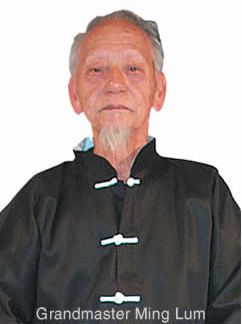 ML: The first group – the students – always the best, no matter what style, what system, whatGrandmaster Ming Lum martial art. The first group of students – always the best! As generations go down, down, down, relax a bit. Because the first group of black belts come out – the first group of instructors ever established in California – like him, like him (points around the table), I see the difference. (Others) kind of lost part of the culture – what they trained for, what is martial art.
ML: The first group – the students – always the best, no matter what style, what system, whatGrandmaster Ming Lum martial art. The first group of students – always the best! As generations go down, down, down, relax a bit. Because the first group of black belts come out – the first group of instructors ever established in California – like him, like him (points around the table), I see the difference. (Others) kind of lost part of the culture – what they trained for, what is martial art.
WJ: In our generation, it was a little harder to get a black belt. Nowadays, they want it quick. You can’t hurry things like that. You can’t help it. You got to go through the process. But they want to get there as fast as they can.
I don’t know. Sometimes one guy promotes one instructor, and another guy gets promoted and again another. So the ranks keep coming up. They really didn’t earn it. The hard part is to control that.
GC: How do you feel about the present trend towards mixed martial arts?
WJ: I think it’s great.
AN: Did you see that last Shamrock fight? Oh, he took a beating. Ortiz – I think he retired him. Ken Shamrock isn’t going to fight anymore.
RC: For mixed martial arts, there’s a foundation that you work on and you strengthen your foundation – being able to work around whatever the problem is – you can. But it’s just like – mixed martial arts – if you’re going out there, you carry two guns, you carry two swords, you going to carry a bow and arrow. Now it’s time for you to fight the guy so you don’t know which one to pull out. It’s confusing.
It’s the person himself. It’s not the system. It’s the person within the system that makes the system. And that’s the key.
I would never, never try to go against a guy that’s a street fighter and try to grapple him. Street fighting is different. If there’s certain rules, you got to go by the rules. They still fight by the rules. You can’t go to the eye. You can’t bite. You can’t do this. That’s a sport. For me, “realistic” means you’re fighting for your life. You can pick up anything and fight. That’s the way it is. Hey, if I pick up this (picks up chopsticks) it’s my weapon already. Yet it’s so innocent, I use it as a chopstick. But I can turn around and use it as a weapon.
And so, it’s an individual. You have the primitive stage, you have the mechanical stage, but the most important is your response energy – how you react in the last few seconds. That’s what’s going to stop him.
ML: I would say that no matter system we learn, it’s the man behind it. You put that in.
GC: Earlier you said that martial arts are losing its culture. Do you think MMA might contribute to that loss?
ML: The students have lost the culture, not the system itself.
AN: It’s entertainment. I like to watch it. I like to watch them beat each other up. I used to do that. So I like to see other people do that too.
RC: I think every system has to offer this, like Wally has. First of all, Wally can say “I’m here to entertain you, but as well, I’m going to educate you.” And that’s what’s important. We can do the entertainment, but at the same time, we are educating you. If you just go for entertainment, like you’re going to a movie, enjoy the show and walk out. And that’s it. No, it’s more than that. You have to relate to the idea that it’s a hobby. You take that first step on a long journey. That’s what it’s all about. But you got to take that first step. But how many can really last that long journey? Not many.
AN: Not by yourself.
RC: We took that long journey and we’re still walking, still going.
AN: (chuckles)
GC: What’s the secret to making that journey?
RC: Because we married one woman and we stuck with her.
ALL: (Laughter and nods of agreement.)
RC: I have fifty-three years. (points at WJ) He has sixty-seven. (points at ML) He has what? Sixty-eight?
ML: Uh, no, fifty-eight.
RC: Whatever. We stuck to one woman. Like Bernice (Jay) says, she makes waves and Wally’s a surfer. I think that’s a good thing to mention to my wife. “Honey, you make waves, but I’m the surfer.” I like that.
GC: What would you like to see as the future of martial arts?
Wally JayWJ: I’d like to see it stick to more tradition. That’s good. Some things you have to change, but I think that new generation, new ideas, brings change. Techniques change, but the feeling has to be the same. They must love martial arts. It’s not only for fighting. It’s spiritual and character building.
AN: We like to go back to tradition. My forms that I teach have never been changed. They learn the right side and the left side. The only thing wrong with the Sil Lum system is that it’s one-sided.
GC: You say “tradition” but you accept that tradition has to adapt. What do you mean by tradition exactly? What is the essence of tradition?
ML: Find a traditional instructor.
WJ: Character building.
RC: What I tell my children, the little ones, about respect. You can say “no” to strangers, but at home you say “yes.” That’s very important. You say “yes” to your family.
I have this story about it. It’s so funny. This little boy, about five years old, he asked his mother something. He said “Mom, can I have this thing?” and she said “No!” He reminds his mom, “Mom, you’re supposed to say ‘no’ to strangers, but at home you say ‘yes.'” This was a month ago. I said “No, no, no, I can tell you ‘no,’ I can tell you ‘yes’. That’s not what the grandmaster said. He said, ‘you say ‘no’ to strangers, but at home, you listen to me.'” (laughs)
GC: How can we bring tradition back?
RC: Like Ming was saying, you teach the very beginning of what you’re taking as a tradition. The respect, the courtesy, you start with that. If you want to make him a fighter, fine, you can make him a fighter. But there’s certain rules in the tournament. You have to tell him, you can’t do this, you can’t do that, but it’s alright for you to do what I’m teaching you.
You develop three types of power. First power rules the outside. The second power breaks the inside. The third stops them completely. You cannot use the third power of striking anybody and killing anybody. You better get a good lawyer. But you can control yourself, and control the opponent. That’s the important point. From the traditional point – the respect for each other – then whatever system you learn, you go to the tournament, you’re allowed to do this. Okay, we train for that. If you teach them the right way, when to fight, when not to fight, I think they’ll understand. To make them a street fighter or a troublemaker, that’s bad. Teach them the right way – the tradition, the respect, everything.
AN: I went to the seminar last week. There were thirty-five black belts there. They all lined up to concentrate on (form) number one. Everyone looked different. The master came up and said, “Now we’re going to do the traditional way.” (laughs) It looked different to me. People were looking, looking, looking. You don’t have to change your form. You can do it your own way. But this was the traditional way.
GC: What do you say to aspiring students?
ML: Keep on practicing (laughs)
AN: Practice, practice, practice!
RC: Perfect practice!
AN: I’m still learning every day.
WJ: Every day you pick up something. Just a little thing. But it gets big in the end.
Written by Gene Ching for KUNGFUMAGAZINE.COM © COPYRIGHT KUNGFUMAGAZINE.COM, ALL RIGHTS RESERVED.
All other uses contact us at gene@kungfumagazine.com.


